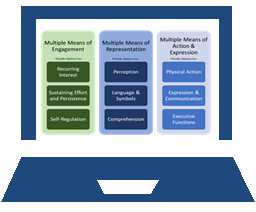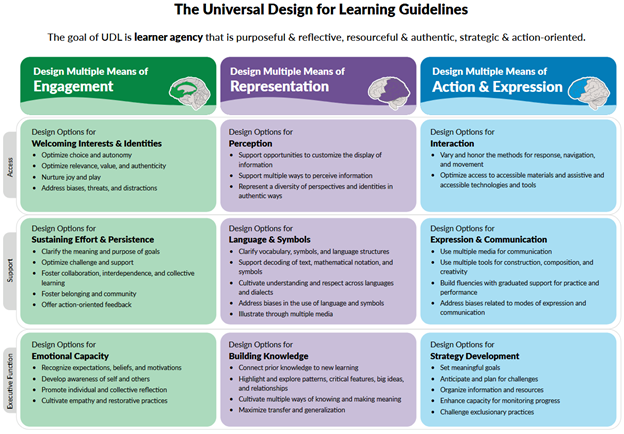Supporting Learners with Autism Spectrum Disorder (ASD) in Online Classrooms: Incorporating a Variety of Strategies to Prevent Sensory Overload
Nizy Samuel
Introduction
![]() Across various learning environments, learners with autism spectrum disorder (ASD) face challenges in accessing learning materials effectively due to a variety of environmental factors. In particular, learners with ASD encounter difficulties in accessing learning resources on online learning platforms due to the potential for sensory overload (Haidai et al., 2025). Sensory overload is a term used to characterize the sensory challenges faced by individuals with ASD that can affect all or some of the 8 sensory systems including visual (sight), gustatory (taste), olfactory (smell), vestibular (balance), auditory (hearing), tactile (touch), interoception (awareness of internal states) and proprioception (bodily awareness) as highlighted in Figure 1 (Bennie, 2024; Neff, 2022). Challenges related to sensory overload can affect up to 90% of individuals diagnosed with autism and can cause challenges in communicating effectively, engaging with peers, as well as managing behavior (Bennie, 2024). As a result, relevant strategies must be employed by academic institutions and educators to provide learners with ASD with the necessary tools and strategies to ensure that online learning environments address and account for the sensory overload that may be experienced by individuals with ASD.
Across various learning environments, learners with autism spectrum disorder (ASD) face challenges in accessing learning materials effectively due to a variety of environmental factors. In particular, learners with ASD encounter difficulties in accessing learning resources on online learning platforms due to the potential for sensory overload (Haidai et al., 2025). Sensory overload is a term used to characterize the sensory challenges faced by individuals with ASD that can affect all or some of the 8 sensory systems including visual (sight), gustatory (taste), olfactory (smell), vestibular (balance), auditory (hearing), tactile (touch), interoception (awareness of internal states) and proprioception (bodily awareness) as highlighted in Figure 1 (Bennie, 2024; Neff, 2022). Challenges related to sensory overload can affect up to 90% of individuals diagnosed with autism and can cause challenges in communicating effectively, engaging with peers, as well as managing behavior (Bennie, 2024). As a result, relevant strategies must be employed by academic institutions and educators to provide learners with ASD with the necessary tools and strategies to ensure that online learning environments address and account for the sensory overload that may be experienced by individuals with ASD.
Some strategies to support learners with ASD include, but are not limited to, employing Universal Design for Learning (UDL) and User-Centred Design (UCD) principles in online classrooms and providing digital teaching and/or learning resources to ensure that educators and learners with ASD are equipped to teach and learn respectively (Buckner, n.d.; CAST, 2024; Kirk, 2025; Kutest Kids, n.d.; Silva et al., 2025; Wang, 2024). Additionally, raising awareness about the challenges faced by learners with ASD on online learning platforms by conducting additional research and addressing the limitations of existing research can ensure that the strategies employed to equip learners with ASD remain relevant and appropriate (Wang, 2024).

Note. The different types of sensory inputs include proprioception, tactile, vestibular, gustatory, auditory, visual, olfactory and interoception (Neff, 2022).
Addressing ASD Sensory Overload in Online Learning Environments
 According to Wang (2024), some estimates suggest that 1% of the global population has been diagnosed with ASD. This is a significant number of individuals who may face challenges navigating existing online learning platforms that may not account for the specific needs of learners with ASD, the majority of whom experience sensory overload (Wang, 2024). In online learning environments, learners with ASD experience sensory overload due to a variety of environmental and design-related factors (Kirk, 2025). Some common challenges are related to the lack of adaptability of some online classroom platforms and the absence of appropriate assistive tools (Kirk, 2025). These challenges can be addressed by employing a combination of strategies, including providing relevant resources to educators and learners as well as designing online classrooms with intentionality and inclusive practices in mind (Kirk, 2025).
According to Wang (2024), some estimates suggest that 1% of the global population has been diagnosed with ASD. This is a significant number of individuals who may face challenges navigating existing online learning platforms that may not account for the specific needs of learners with ASD, the majority of whom experience sensory overload (Wang, 2024). In online learning environments, learners with ASD experience sensory overload due to a variety of environmental and design-related factors (Kirk, 2025). Some common challenges are related to the lack of adaptability of some online classroom platforms and the absence of appropriate assistive tools (Kirk, 2025). These challenges can be addressed by employing a combination of strategies, including providing relevant resources to educators and learners as well as designing online classrooms with intentionality and inclusive practices in mind (Kirk, 2025).
Sensory overload in learners with autism attending classes in online learning environments can contribute to negative learning outcomes if left unaddressed (ILA, n.d.). Sensory overload creates challenges for learners with ASD in prioritizing sensory stimuli, which can cause them to focus on certain stimuli either excessively or insufficiently in comparison to neurotypical individuals (Schrader, 2020). This can lead to anxiety, frustration, and even feelings of anger as they are overwhelmed by the onslaught of sensory information that they are required to process (Schrader, 2020). As a result, learners with ASD can find it challenging to participate in online learning platforms that are designed poorly, which can be a source of overwhelmingly bright screens or unexpectedly loud noises (ILA, n.d.). Therefore, it is imperative that appropriate strategies are employed to support individuals with ASD as they learn in online environments.
Proposed Solution 1: Employ Appropriate Instructional Design Strategies
 A potential solution to address the adverse effects of sensory overload experienced by students with ASD is to employ appropriate instructional design strategies based on Universal Design for Learning (UDL) principles. UDL provides strategies for addressing and meeting the needs of diverse learners, and aims to eliminate any barriers that may exist through the design and planning of the course (CAST, 2024). As highlighted in Figure 2, the three principles of UDL include providing learners with multiple means to engage, represent learning material, and act/express themselves (CAST, 2024). By incorporating these principles, online learning platforms designed with UDL principles can cater to learners with ASD as learners are provided with alternative means to engage with the learning material and minimize the distractions that may contribute to sensory overload (Anderson, 2020). For example, decreasing face-to-face interactions by designing inclusive online classrooms can help minimize the distractions that are experienced by learners with ASD (Anderson, 2020). Therefore, applying UDL principles to an online learning platform can benefit learners with ASD and improve learning outcomes as learners are provided with alternative ways to engage with the learning without being overwhelmed.
A potential solution to address the adverse effects of sensory overload experienced by students with ASD is to employ appropriate instructional design strategies based on Universal Design for Learning (UDL) principles. UDL provides strategies for addressing and meeting the needs of diverse learners, and aims to eliminate any barriers that may exist through the design and planning of the course (CAST, 2024). As highlighted in Figure 2, the three principles of UDL include providing learners with multiple means to engage, represent learning material, and act/express themselves (CAST, 2024). By incorporating these principles, online learning platforms designed with UDL principles can cater to learners with ASD as learners are provided with alternative means to engage with the learning material and minimize the distractions that may contribute to sensory overload (Anderson, 2020). For example, decreasing face-to-face interactions by designing inclusive online classrooms can help minimize the distractions that are experienced by learners with ASD (Anderson, 2020). Therefore, applying UDL principles to an online learning platform can benefit learners with ASD and improve learning outcomes as learners are provided with alternative ways to engage with the learning without being overwhelmed.

Note. The principles outlined by UDL include creating multiple means of engaging learners, multiple means of representing learning material, as well as multiple means of action and expression (CAST, 2024).
In addition, User-Centred Design (UCD) principles can be employed to address the specific needs of learners with ASD in online learning platforms (Kirk, 2025). UCD principles include employing a multidisciplinary approach to designing online platforms to consider the diverse needs of users and incorporate user feedback to improve the design of the platform (Interaction Design Foundation, 2025). These principles can be applied to online learning platforms to ensure that students with ASD are supported in their learning, as classrooms that are adaptable to address the specific needs of learners with ASD can be beneficial in mitigating the effects of sensory overload (Kirk, 2025). Assistive tools such as visual timers and other visual aids can also be incorporated into the design of the classroom to ensure that learners with ASD are supported within their online classrooms (Kirk, 2025). These design strategies can ensure that the sensory overload experienced by students with ASD is minimized. Therefore, UCD principles can be used to inform the design of online classrooms to provide learners with ASD with the appropriate tools to thrive in online learning settings.
Proposed Solution 2: Provide Digital Teaching Resources to Support Educators
 Another potential solution to address the challenges faced by learners with ASD on online platforms due to sensory overload includes providing educators with the appropriate digital teaching resources and training to support their students (Kutest Kids, n.d.). For example, educators can be trained in employing interactive learning strategies that address the sensory needs of students with ASD to ensure that they are equipped to support their learners adequately (Kutest Kids, n.d.). Some interactive learning strategies aimed at addressing sensory stimuli include facilitating mindfulness activities and providing colouring pages, which can allow students with ASD to regulate their responses to sensory stimuli (Kutest Kids, n.d.). Other resources that educators can utilize to support their learners in online settings include online resources such as 826 Digital (826 National, 2025), which can provide downloadable lesson plans with simple graphics related to writing to prevent sensory overload, as well as Bedtime Math (Bedtime Math Foundation, 2025), which hosts math activities with simple graphics and text to ensure that the sensory needs of learners with ASD are met (Nuckner, n.d.). These resources can be beneficial to educators as they plan their lessons to support their learners with ASD in online settings.
Another potential solution to address the challenges faced by learners with ASD on online platforms due to sensory overload includes providing educators with the appropriate digital teaching resources and training to support their students (Kutest Kids, n.d.). For example, educators can be trained in employing interactive learning strategies that address the sensory needs of students with ASD to ensure that they are equipped to support their learners adequately (Kutest Kids, n.d.). Some interactive learning strategies aimed at addressing sensory stimuli include facilitating mindfulness activities and providing colouring pages, which can allow students with ASD to regulate their responses to sensory stimuli (Kutest Kids, n.d.). Other resources that educators can utilize to support their learners in online settings include online resources such as 826 Digital (826 National, 2025), which can provide downloadable lesson plans with simple graphics related to writing to prevent sensory overload, as well as Bedtime Math (Bedtime Math Foundation, 2025), which hosts math activities with simple graphics and text to ensure that the sensory needs of learners with ASD are met (Nuckner, n.d.). These resources can be beneficial to educators as they plan their lessons to support their learners with ASD in online settings.
Proposed Solution 3: Provide Digital Learning Resources to Support Learners with ASD
 Furthermore, a solution to support learners with ASD in overcoming challenges related to sensory overload in online learning settings includes providing appropriate digital learning resources to the learners themselves. For example, online learning resources such as Funbrain (Funbrain Holdings, 2020) are catered towards learners with ASD who require digital books with sensory-friendly modifications such as simple illustrations and text that will prevent sensory overload. Other learning resources that can support learners with ASD in managing sensory stimuli include visual aids, personalized lesson plans, flexible schedules, and online programs that incorporate the unique interests of learners with ASD (ASU, 2025). Providing learners with ASD with these online tools that consider the sensory requirements of ASD learners can be crucial in addressing sensory overload-related challenges (Nuckner, n.d.).
Furthermore, a solution to support learners with ASD in overcoming challenges related to sensory overload in online learning settings includes providing appropriate digital learning resources to the learners themselves. For example, online learning resources such as Funbrain (Funbrain Holdings, 2020) are catered towards learners with ASD who require digital books with sensory-friendly modifications such as simple illustrations and text that will prevent sensory overload. Other learning resources that can support learners with ASD in managing sensory stimuli include visual aids, personalized lesson plans, flexible schedules, and online programs that incorporate the unique interests of learners with ASD (ASU, 2025). Providing learners with ASD with these online tools that consider the sensory requirements of ASD learners can be crucial in addressing sensory overload-related challenges (Nuckner, n.d.).
Proposed Solution 4: Raise Awareness about Challenges Related to Sensory Overload
 Moreover, raising awareness by conducting relevant research and educating the stakeholders involved (e.g., students, educators, parents) about ASD can be a potential solution to address the sensory-related challenges faced by students with ASD in online classrooms. As existing research lacks studies related to ASD in online settings designed using principles like UDL (Anderson, 2020), conducting additional research to address gaps in existing literature can increase awareness about the challenges experienced by learners with ASD in online learning environments (Anderson, 2020). Also, non-ASD individuals can hold biases towards individuals with ASD, especially due to their differing experiences with sensory processing (Wang, 2024). Therefore, educating the stakeholders involved about the sensory-related challenges faced by learners with ASD using multisensory interactive devices that simulate ASD-related sensory overload for individuals who are non-ASD can help raise awareness and address biases (Wang, 2024). Stakeholders can also be educated about strategies to support learners with ASD through workshops, presentations, and events tailored to raise awareness about ASD (Rising Above ABA, 2024). These strategies to raise awareness about the experiences of individuals with ASD can provide educators and learners with the opportunity to understand their peers with ASD and support them as needed, combating the existing stigma associated with ASD (Wang, 2024).
Moreover, raising awareness by conducting relevant research and educating the stakeholders involved (e.g., students, educators, parents) about ASD can be a potential solution to address the sensory-related challenges faced by students with ASD in online classrooms. As existing research lacks studies related to ASD in online settings designed using principles like UDL (Anderson, 2020), conducting additional research to address gaps in existing literature can increase awareness about the challenges experienced by learners with ASD in online learning environments (Anderson, 2020). Also, non-ASD individuals can hold biases towards individuals with ASD, especially due to their differing experiences with sensory processing (Wang, 2024). Therefore, educating the stakeholders involved about the sensory-related challenges faced by learners with ASD using multisensory interactive devices that simulate ASD-related sensory overload for individuals who are non-ASD can help raise awareness and address biases (Wang, 2024). Stakeholders can also be educated about strategies to support learners with ASD through workshops, presentations, and events tailored to raise awareness about ASD (Rising Above ABA, 2024). These strategies to raise awareness about the experiences of individuals with ASD can provide educators and learners with the opportunity to understand their peers with ASD and support them as needed, combating the existing stigma associated with ASD (Wang, 2024).
Limitations
 Some limitations exist in implementing the solutions outlined in this chapter, which include the absence of literature related to the implementation of some UDL and UCD principles within online learning platforms, as well as the funding required to implement the solutions required to support learners with ASD (Anderson, 2020; Kirk, 2025; Koch et al., 2021). The existing knowledge gap within current literature related to the specific needs of learners with ASD based on gender differences is particularly noteworthy as well and requires additional research (Lynch et al., 2022). Gaps in existing research also include the challenges associated with applying UDL and UCD principles to online learning platforms, requiring additional research (Anderson, 2020; Kirk, 2025) In addition, implementing the aforementioned solutions may require additional funding from academic institutions and governmental agencies as school boards are often underfunded and lack the necessary resources to support learners with ASD (Koch et al., 2021).
Some limitations exist in implementing the solutions outlined in this chapter, which include the absence of literature related to the implementation of some UDL and UCD principles within online learning platforms, as well as the funding required to implement the solutions required to support learners with ASD (Anderson, 2020; Kirk, 2025; Koch et al., 2021). The existing knowledge gap within current literature related to the specific needs of learners with ASD based on gender differences is particularly noteworthy as well and requires additional research (Lynch et al., 2022). Gaps in existing research also include the challenges associated with applying UDL and UCD principles to online learning platforms, requiring additional research (Anderson, 2020; Kirk, 2025) In addition, implementing the aforementioned solutions may require additional funding from academic institutions and governmental agencies as school boards are often underfunded and lack the necessary resources to support learners with ASD (Koch et al., 2021).
Conclusion
Learners with ASD experience challenges with accessing learning material on online learning platforms due to sensory overload that can impact various aspects of their learning experience, including communicating effectively and engaging with their peers (Bennie, 2024). This can contribute to adverse learning outcomes, which can be addressed by incorporating UDL and UCD principles in classrooms, as well as employing teaching and learning strategies that address and mitigate sensory overload in learners with ASD (Buckner, n.d.; CAST, 2024; Kirk, 2025; Kutest Kids, n.d.; Silva et al., 2025; Wang, 2024). By conducting additional research and addressing the existing limitations of current research, which include the sparse amount of current research related to online learning platforms designed using UDL and UCD principles (Anderson, 2020; Kirk, 2025), learners with ASD can be supported throughout their learning journey on online learning platforms without experiencing significant challenges related to sensory overload.
References
826 National (2025). Browse free writing prompts. 826digital. https://826digital.com/
Anderson, A. (2020). Universal Design Online and Students on the Autism Spectrum: Is it a Match?. In Society for Information Technology & Teacher Education International Conference (pp. 1995–2001). Association for the Advancement of Computing in Education (AACE). https://www.learntechlib.org/primary/p/215979/
Arizona State University (ASU). (2025). Explore free online school options for students with Autism. https://www.asuprepdigital.org/blog/free-online-school-for-students-with-autism/
Bedtime Math Foundation. (2025). A quick 12-hour game of golf. Bedtime Math. https://bedtimemath.org/
Bennie, M. (2025). What does sensory overload look like and how can we help?. Autism Awareness. https://autismawarenesscentre.com/what-does-sensory-overload-look-like-and-how-can- we-help/
CAST. (2024). The UDL guidelines. The UDL Guidelines. https://udlguidelines.cast.org/
Funbrain Holdings (2020). Home. Funbrain. https://www.funbrain.com/
Ignite Learning Academy (ILA). (n.d.). Do autistic children struggle with online learning?. Ignite Learning Academy. https://ignitelearningacademy.com/blog/do-autistic-children-struggle-with-online-learning
Interaction Design Foundation. (2025). What is User Centered Design (UCD)? – updated 2025. The Interaction Design Foundation. https://www.interaction-design.org/literature/topics/user-centered-design
Kirk, V. (2025). A sensory-friendly learning environment through design: User experience and implementation. Theseus. https://www.theseus.fi/handle/10024/878487
Kutest Kids. (n.d.). How to use interactive learning to support children with Autism. https://www.kutestkids.com/blog/how-to-use-interactive-learning-to-support-children-with-autism
Lynch, P., Singal, N., & Francis, G. A. (2022). Educational Technology for learners with disabilities in primary school settings in low- and middle-income countries: A systematic literature review. Educational Review, 76(2), 405–431. https://doi.org/10.1080/00131911.2022.2035685
Neff, M. A. (2022). 8 senses of the body: Exploring the hidden sensory systems. Neurodivergent Insights. https://neurodivergentinsights.com/8-senses/
Nuckner, L. (n.d.). Educational and sensory-friendly online resources for children with autism. Sensory Kid. https://www.sensorykid.info/blog/educational-and-sensory-friendly-online-resources-for-children-with-autism/
Rising Above ABA. (2024). Autism awareness for teachers and staff. https://www.risingaboveaba.com/autism-blog/autism-awareness-for-teachers-and-staff
Schrader, J. (2020). Making sense of sensory overload in autism and ADHD. Psychology Today. https://www.psychologytoday.com/ca/blog/1-2-3-adhd/202004/making-sense-sensory-overload-in-autism-and-adhd
Silva, R. M., Martins, P., & Rocha, T. (2025). Virtual reality educational scenarios for students with ASD: Instruments validation and design of stem programmatic contents. Research in Autism Spectrum Disorders, 119, 102521. https://doi.org/10.1016/j.rasd.2024.102521
Wang, H. (2024). Overwhelmed: Conceptual design of an interactive device for Autism sensory overload experience. Third International Conference on Intelligent Mechanical and Human-Computer Interaction Technology (IHCIT 2024), 66. https://doi.org/10.1117/12.3049647
